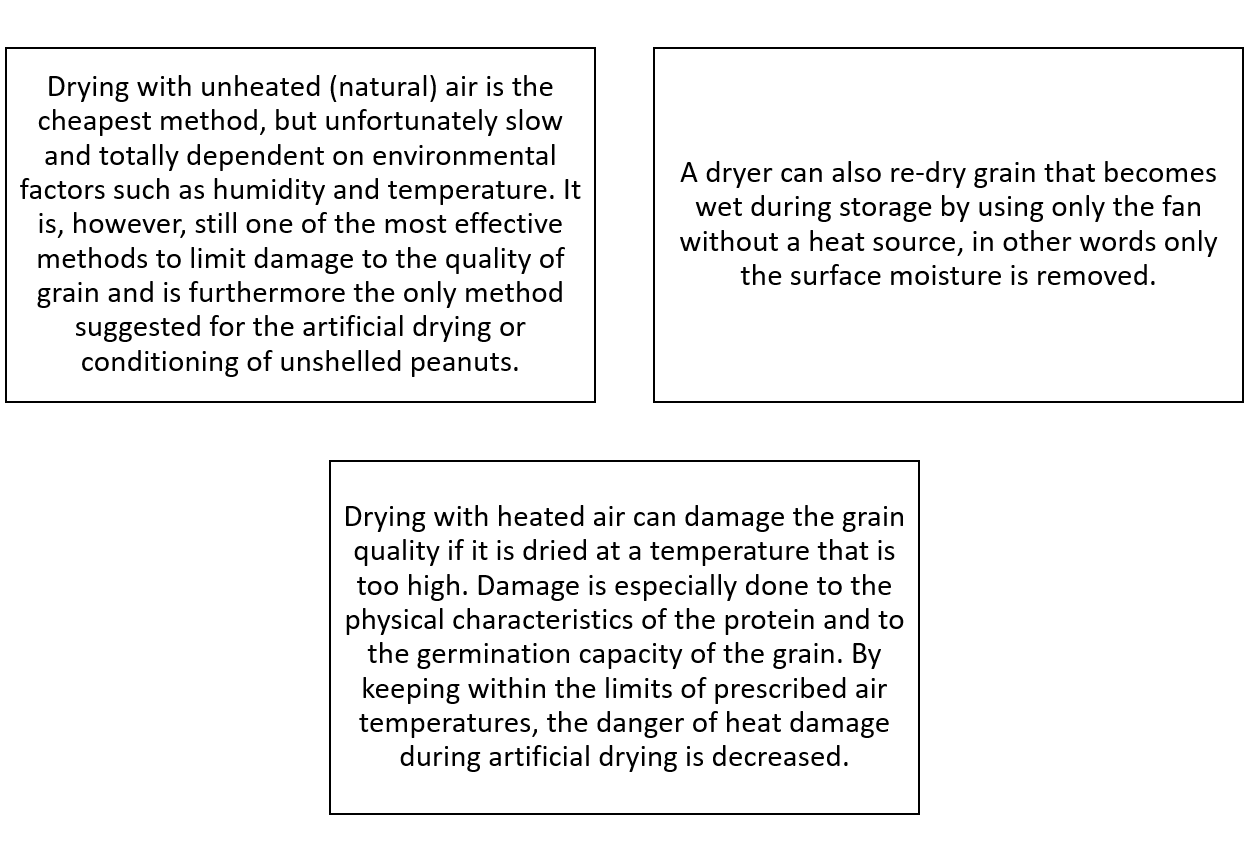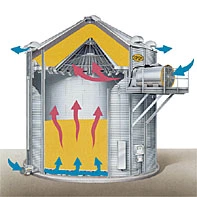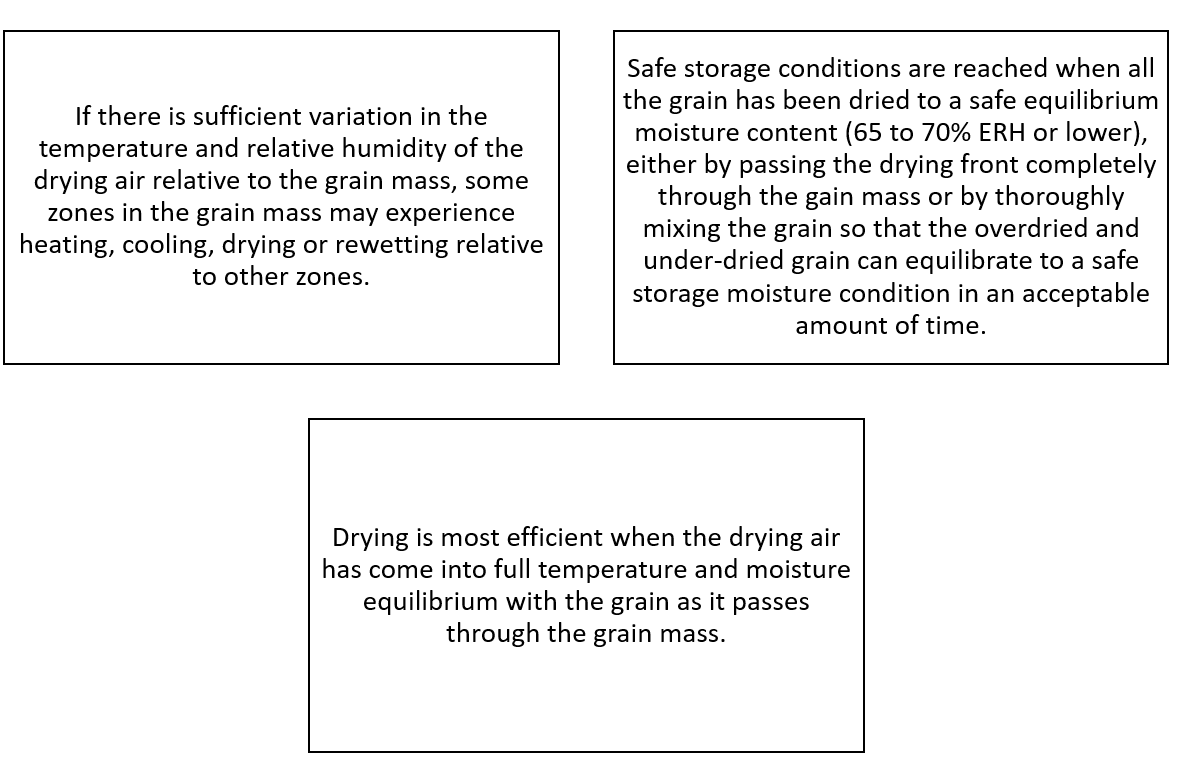When the grain is dried, the excess water (moisture) is removed from it. The removal takes place by water being taken up in the air and being blown away. Different drying equipment and techniques as well as methods of drying are used. Dryers make use of forced air as a drying medium. The air can be heated or unheated.
Drying is usually the most economical choice for the successful storage of grain and seed products, especially in the long term. Economic considerations that influence the decision about the type of drying and storage system to purchase include the following:
- Opportunity for an earlier harvest, which reduces the potential for weather- and pest-related field losses while maintaining the quality and quantity of harvested grain and seeds.
- Reducing the net price penalty (dockage) from the sale of high-moisture grain and seeds.
- Increasing options regarding when, where, and for what purpose, the grain may be sold or used for feed.
- Risks associated with the processing and maintenance of grain between harvest and time of sale are reduced.
Drying Methods

Drying Equipment
There are two types of heat drying equipment, namely one with direct heating and one with heating through a heat exchanger. When a heat exchanger is used, only clean air will be blown through the grain. With the direct heating system, the products of combustion move with the heated air through the grain that is being dried and the danger of pollution is very big, especially if the combustion is not complete. In all respects, it is thus preferable that a grain dryer must have a heat exchanger. Grain easily absorbs a smell or a taste. Huge losses can be incurred by, for example, drying grain with hot air that has an oily or other smell.
Preparations for Drying Grain
Ensure that the drying oven is clean and functional at the start of the season.
Prepare empty bins for the storage of wet grain and also dried grain.
Ensure that the igniting chamber is clean and that the nozzle is without residue.
Ensure that the bin with the wet grain is emptied after about two weeks before any new wet grain is added to it. This prevents a wet grain cushion is formed.
Ensure that the dried grain is cooled down to the environmental temperature before it is stored in a bin.
Determine the moisture of grain that is being dried at least every 20-30 minutes to ensure that the correct quantity of moisture is removed.
Notwithstanding the type of moisture testing equipment that is in use, all equipment must be tested for accuracy against the standard 72-hour oven method. The method is used by an accredited laboratory.
What Happens When Grain is Dried
An air molecule can be compared to a sponge since it takes up moisture. A saturated air molecule has 100% relative humidity and a dry molecule has 0% relative humidity. The quantity of moisture that must be removed could be removed with heat and air.
The degree to which the air takes up moisture is dependent on the equilibrium point between the air moisture and the grain moisture. The moisture in the grain has a certain vapour pressure. The result is that the vapour pressure in the grain decreases until it is the same as the vapour pressure in the air, and no more moisture exchange takes place between the grain and the air.
As a rule of thumb, it can be assumed that 1.25 kW is needed to extract 1kg of water from the grain.
In a poorly-designed dryer, the kW usage could be even higher. It is possible that wet grain could be mixed with dry grain due to a lack of knowledge of employees that operate dryers at night. A lot of damage to grain could thus be caused due to the excessive high-water content of the so-called dried grain.
It is therefore very important that all dried grain is first transferred into a post-dryer bin to cool off and reach equilibrium with its environment. When the post-dryer grain is transferred, moisture and temperature tests must be taken at least every 30 minutes to ensure that the grain is dried properly and that the temperature of the grain is not too high. These results must be recorded.
If all dried grain is transferred to bins with temperature monitoring, it can facilitate the management thereof and it is then possible to detect any abnormalities and take corrective action before damage is done to the grain. It is important that comprehensive notes are taken when the grain is transferred into a bin. The principle of first-in-first-out should be followed, but unfortunately it is not possible. Therefore, it is always advisable to empty the bins first to make very sure of the condition of the grain before more grain is added. Where wet grain is dried without aeration, it should be noted that the safe storage time of wet grain should not be exceeded. The moment that situation occurs, the moisture content must be reduced and as soon as the situation normalizes, it can be increased again.
Those involved with the management, operation, and design of drying systems need to understand the principles of drying and how a particular situation may dictate the desired final moisture content for the storage of grain and the selection of a drying method.
In most grain drying systems, ambient air is heated and passed through the grain so that a relatively high vapour pressure gradient is produced between the moisture in the grain and the moisture in the drying air. This differential causes moisture to move from the grain to the air that is flowing past the kernel where it is then exhausted from the grain mass to the outside atmosphere.
 |
 |
In the most simplistic drying situation, the grain and the air that surrounds it are in equilibrium before the introduction of heated air, and the properties and rate of flow of the heated air entering the grain mass remain constant during the drying period. In such a situation, the heated air transfers its heat to the grain and creates a new equilibrium moisture content based on the new differential vapour pressure. The drying air begins absorbing moisture from the first kernels that the air contacts. This process continues until the drying air, falling in temperature and increasing in relative humidity, can no longer add additional moisture because it is in equilibrium with the remaining grain mass.
Simultaneously, the transfer of moisture from the grain to the drying air becomes increasingly more difficult as the grain dries, so much so that stress cracks can occur if the grain is dried too quickly or is overdried. Effectively, the above process produces a drying front and a drying zone. All grain behind the trailing edge of the drying zone would be in a new, stable equilibrium moisture condition with the heated air. The grain ahead of the drying zone would remain essentially in its initial equilibrium moisture condition. The grain in the drying zone would range from its highest moisture content at the start (leading edge) of the drying zone to being driest at the end (trailing edge) of the drying zone.
The simplistic drying situation described above seldom happens for very long. In practice, the grain being dried varies during the harvest period (gradually losing moisture in the field during harvest) in temperature and moisture content and may contain different levels of fines and trash that influence the distribution of airflow. Heat is lost or gained in the grain mass because of changes in ambient air conditions surrounding the mass. Properties of the ambient and heated air also change during the drying process as daily weather changes occur.
Given all of this, there are some generalizations that should be considered when evaluating the drying process:

Click here to view a video that explains managing moisture levels in grain.